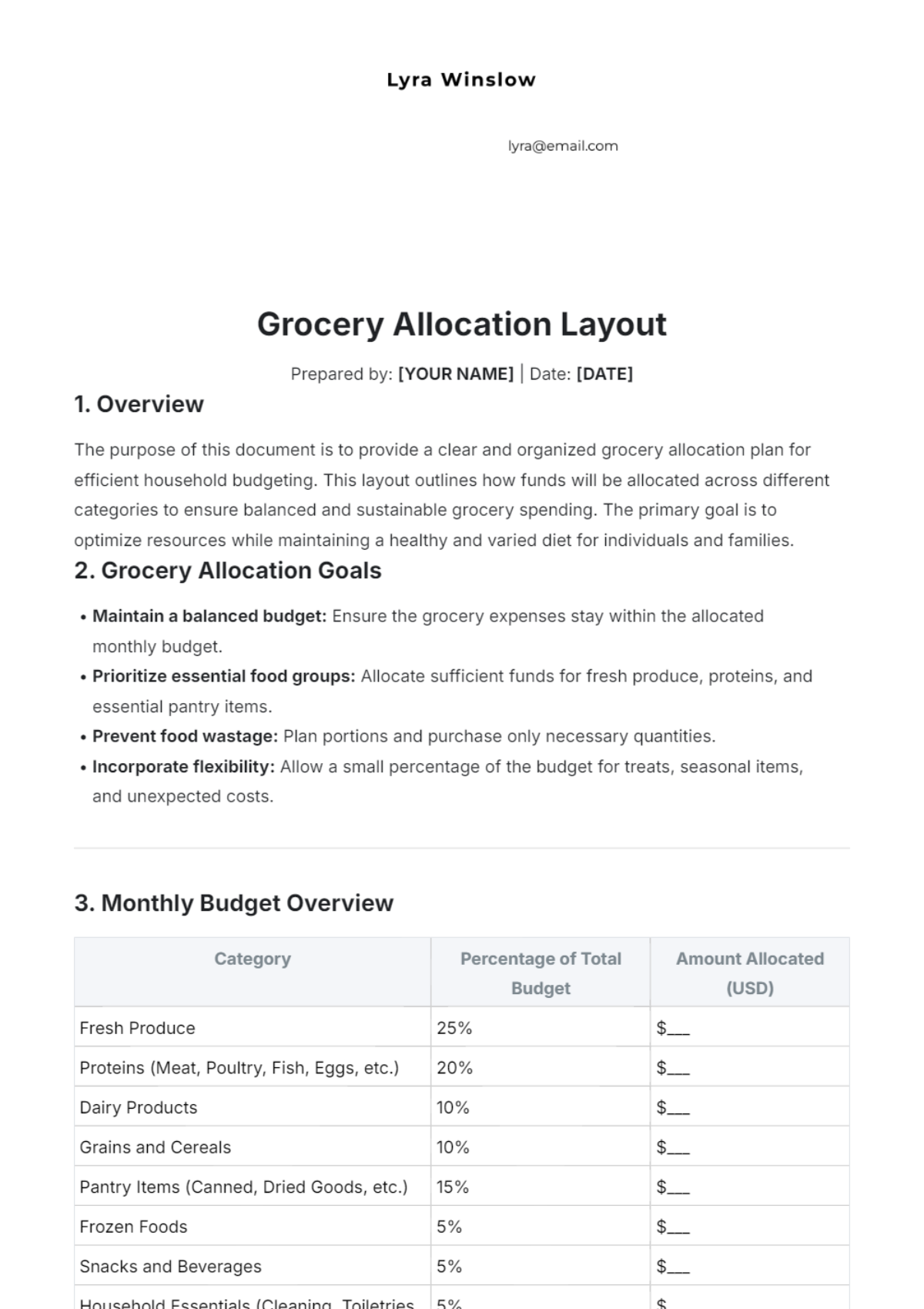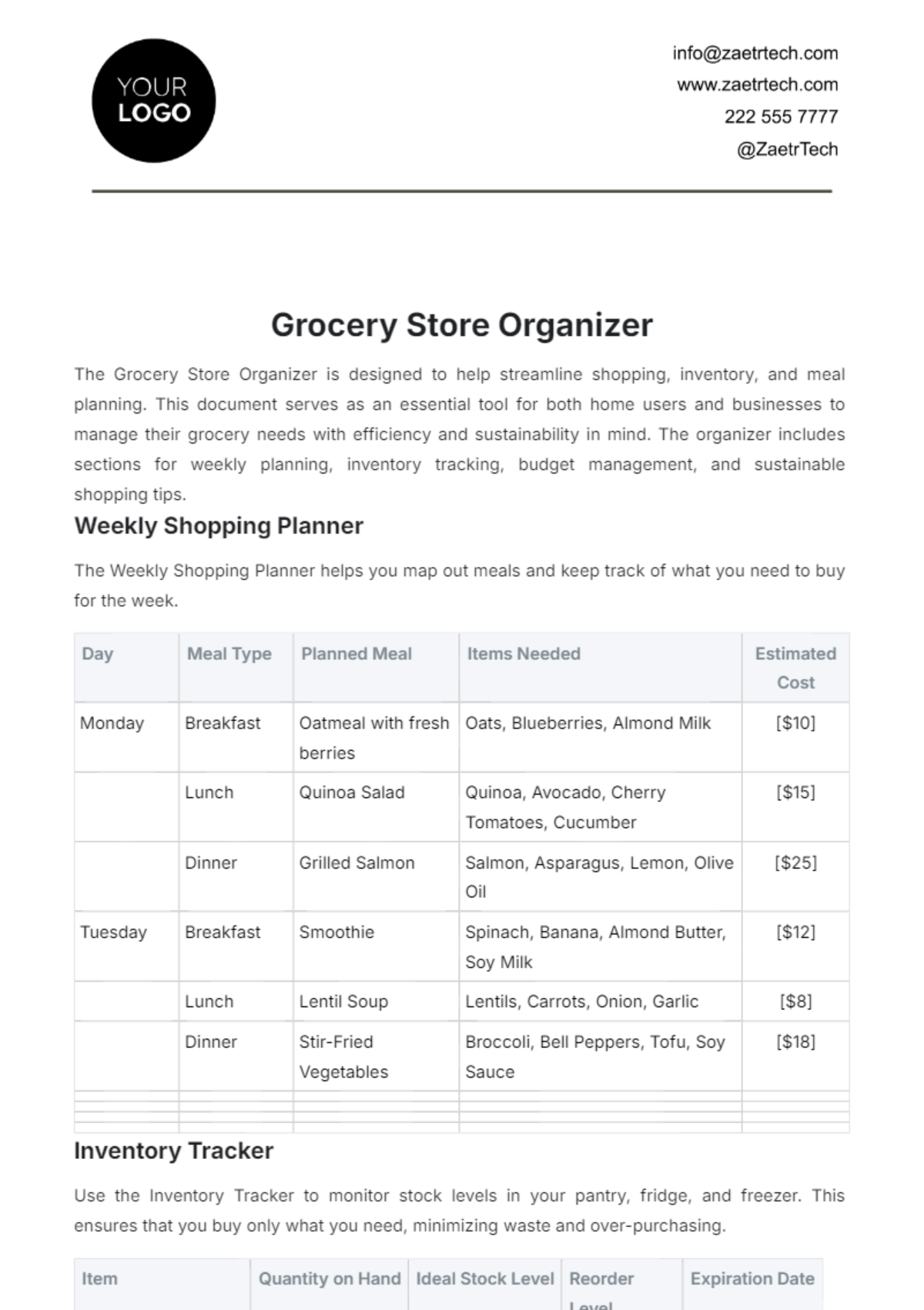Simple Grocery Store Cash Handling SOP
I. Introduction
A. Purpose
The purpose of [Your Company Name]'s Standard Operating Procedure (SOP) is to ensure the integrity and security of all cash handling processes within the grocery store. It aims to establish clear, consistent procedures for managing cash transactions to minimize errors and prevent theft or fraud. This SOP provides guidelines to protect both the financial assets of the store and the safety of its employees.
B. Scope
This SOP applies to all employees who handle cash, including but not limited to cashiers, shift supervisors, store managers, finance/accounting personnel, and loss prevention officers. It covers procedures from the opening of cash registers to the deposit of daily cash receipts. The SOP is relevant to all store locations and must be adhered to at all times to ensure operational consistency and security.
C. Objectives
The objectives of this SOP are to maintain accurate cash handling records, ensure the safety and security of cash assets, and comply with relevant financial regulations. The store's new procedures aim to minimize financial discrepancies, boost cash management efficiency, and provide clear employee guidance to foster accountability and responsibility.
II. Roles and Responsibilities
A. Cashiers
Cashiers are responsible for accurately processing all customer transactions, including sales, returns, and exchanges. They must ensure that the cash drawer is balanced at the beginning and end of each shift, reporting any discrepancies immediately to the shift supervisor. Cashiers are also tasked with maintaining the security of their cash drawer, following all procedures for cash handling, and providing excellent customer service.
B. Shift Supervisors
Shift supervisors oversee the cash handling activities of cashiers, ensuring adherence to the SOP. They assist in balancing cash drawers, preparing cash deposits, and resolving any discrepancies reported by cashiers. Additionally, shift supervisors are responsible for training new cashiers on cash handling procedures and monitoring compliance during their shifts.
C. Store Managers
Store managers are accountable for the overall implementation and enforcement of the cash handling SOP. They conduct periodic audits to ensure compliance with procedures and address any issues related to cash handling promptly. Store managers also collaborate with finance and loss prevention personnel to investigate discrepancies and implement corrective actions as needed.
D. Finance/Accounting Personnel
Finance or accounting personnel maintain accurate records of all cash transactions, ensuring they are properly documented and reconciled. They are responsible for verifying daily cash deposits, identifying any inconsistencies, and reporting these to management. Additionally, finance personnel provide insights and recommendations for improving cash handling processes and controls.
E. Loss Prevention Officers
Loss prevention officers implement and monitor security measures to safeguard cash assets within the store. They review surveillance footage related to cash handling areas and investigate any incidents of theft or fraud. Loss prevention officers also work with management to develop and update security protocols, ensuring they remain effective and up-to-date.
III. Cash Register Operations
A. Opening the Cash Register
Logging In
Cashiers must log in using their unique identification code at the start of their shift to ensure accountability and trackability of all transactions. Verify login by checking the register display for your name or ID. Report any issues to the shift supervisor immediately.
Starting Cash Float
Each cashier is provided with a predetermined amount of starting cash, known as the cash float, at the beginning of their shift. The cashier must count and verify the float before transactions. Report any discrepancies to the shift supervisor immediately.
B. Processing Transactions
Sales Transactions
Cashiers must enter each item accurately into the register and ensure that the correct prices are applied, including any discounts or promotions. They should always give a receipt, count change, and follow store protocols for any issues.
Returns and Exchanges
Returns and exchanges must be processed following the store’s return policy, which includes verifying the original purchase receipt and inspecting the returned items. Cashiers must record returns/exchanges in the register, ensure correct refunds/credits, and escalate any issues to the shift supervisor.
Handling Coupons and Discounts
Cashiers are responsible for verifying the validity of all coupons and discounts before applying them to a transaction. Check expiration dates, product eligibility, and terms on the coupon. Decline invalid coupons politely and address customer concerns per store guidelines.
C. Closing the Cash Register
Logging Out
At the end of their shift, cashiers must log out using their unique identification code to ensure that all transactions are accurately attributed to the correct cashier. Verify the logout process on the register display and report any issues to the shift supervisor immediately.
End-of-Shift Balancing
Cashiers are required to count the cash in their drawer and compare it with the register total at the end of their shift. Report any cash-register discrepancies to the shift supervisor immediately to address errors and maintain accurate financial records.
IV. Cash Drawer Management
A. Maintaining the Cash Drawer
Organizing Bills and Coins
Cashiers should organize bills by denomination, with higher denominations at the back and lower denominations at the front of the drawer. Separate coins by type and place them in designated slots to ensure quick, accurate access and reduce errors during transactions. An organized cash drawer speeds up the process.
Making Change
When making change, cashiers should count the change back to the customer to ensure accuracy and prevent disputes. Use smaller bills and coins to maintain the float. Inform the shift supervisor if change runs low.
B. Cash Drawer Security
Locking the Cash Drawer
The cash drawer must be locked when not in use, such as during breaks or at the end of a shift, to prevent unauthorized access. Cashiers must lock the drawer securely and store the key safely. Only authorized personnel should access the drawer key for security.
Access Control
Access to the cash drawer should be limited to authorized personnel only, such as cashiers and shift supervisors. Record any non-transaction access to the cash drawer in the logbook, noting date, time, reason, and personnel to ensure accountability.
V. Cash Deposit Procedures
A. Preparing Deposits
Counting Cash
At the end of each shift or day, the shift supervisor or designated personnel must count all cash collected during the period. Ensure cash from all registers matches recorded sales totals. Document and investigate discrepancies before making the deposit.
Documenting Deposits
All cash deposits must be documented using a deposit slip, detailing the amount of cash, checks, and any other forms of payment included. The preparer should sign the documentation, and a second authorized person should verify it. Keep copies of deposit slips for records and audits.
Sealing Deposit Bags
Cash deposits should be placed in secure, tamper-evident bags before being transported to the bank. Label and seal each bag with the date, store location, and deposit amount in front of a witness to ensure deposit integrity and clear custody.
B. Transporting Deposits
Designated Personnel
Only authorized personnel should be assigned to transport cash deposits to the bank. Designated personnel, who must pass background checks and receive training, ensure secure and trustworthy cash deposits.
Security Measures
Deposits should be transported using secure methods, such as armored vehicles or escorted trips, to minimize the risk of theft or loss. Vary deposit routes and times to avoid criminal targeting, and ensure personnel carry a communication device for emergencies.
VI. Training and Compliance
A. Employee Training
Initial Training
All new employees who will handle cash must undergo comprehensive training on the store’s cash handling SOP before starting their duties. This training should cover cash register operations, security protocols, and deposit procedures to minimize errors and enhance cash handling security.
Ongoing Training
Regular refresher training sessions should be conducted for all employees to reinforce proper cash handling procedures and introduce any updates to the SOP. These sessions ensure accuracy, security, and address employee concerns, while ongoing training keeps staff proficient in cash handling.
B. Monitoring Compliance
Audits and Inspections
Periodic audits and inspections should be conducted to ensure compliance with the cash handling SOP. Audits may review transactions, verify cash drawers, and observe handling practices. Document and address any SOP deviations promptly to maintain integrity.
Reporting Discrepancies
Employees are encouraged to report any discrepancies or suspicious activities related to cash handling to their supervisor or the loss prevention officer immediately. Establish a clear reporting process to ensure thorough investigations, fostering accountability and vigilance in the store.
C. Policy Updates
Reviewing the SOP
The cash handling SOP should be reviewed regularly, at least annually, to ensure that it remains effective and up-to-date. The review process should include input from store managers, finance staff, and loss prevention officers to identify improvements. Regular reviews ensure the SOP remains effective and adaptable.
Communicating Changes
Any updates or changes to the SOP should be communicated clearly and promptly to all employees. Use training sessions, staff meetings, or written communications to ensure all staff understand SOP changes for consistent and secure cash handling.
VII. Security Measures
A. Surveillance
Camera Placement
Surveillance cameras should be strategically placed to cover all cash handling areas, including registers, cash offices, and deposit preparation zones. Cameras should offer clear views of cash handling to ensure monitoring and deter theft.
Monitoring and Recording
Surveillance footage should be monitored regularly by authorized personnel to identify and respond to any suspicious behavior promptly. Store recorded footage securely for 30-90 days for review of any incidents. Regular monitoring enhances security and ensures accurate records.
Access to Surveillance Footage
Access to surveillance footage should be restricted to authorized personnel only, such as store managers and loss prevention officers. Log all access to the footage, noting who, when, and why, to maintain system integrity and ensure accountability.
B. Cash Storage
Safe and Vault Usage
All cash not immediately needed for transactions should be stored in a secure safe or vault. Equip storage with tamper-evident features and multi-factor authentication to reduce theft and keep cash secure.
Access Control
Access to safes and vaults should be limited to authorized personnel, with access codes or keys being changed regularly and whenever an employee with access leaves the company. Keep a log of safe access, noting date, time, and personnel, to track cash access.
Daily Cash Limits
Set limits on the amount of cash that can be kept in registers and storage areas at any given time. Periodically transfer excess cash to the safe to minimize potential losses from robbery or theft.
C. Emergency Procedures
Robbery Protocols
In the event of a robbery, employees should be trained to remain calm and comply with the robber's demands to ensure their safety. Avoid sudden movements, observe the robber, and stay safe. Notify police and management right after, with full details.
Discrepancy Reporting
Any discrepancies in cash handling, such as shortages, overages, or suspicious transactions, should be reported immediately to the shift supervisor or store manager. File detailed reports and initiate an investigation to find the cause and address issues. Prompt reporting ensures accurate records and timely problem resolution.
Employee Safety
Employee safety is a top priority in all cash handling procedures. Employees should prioritize their safety and follow emergency protocols during threats. Regular training ensures proper response in emergencies.
VIII. Record Keeping and Reporting
A. Transaction Records
Daily Transaction Logs
All cash transactions, including sales, refunds, and deposits, must be logged daily, with records kept for auditing and review purposes. Logs should detail the transaction amount, cashier ID, and any notes to ensure transparency and accountability.
Audit Trails
An audit trail should be maintained for all cash handling activities, documenting the flow of cash from the register to the deposit. This includes cash counts, deposit preparations, and adjustments. An audit trail ensures accurate financial reporting by identifying discrepancies.
Retention Period
All cash handling records should be retained for a specified period, typically in compliance with legal and regulatory requirements. This period typically lasts 1-7 years, based on record type and regulations, ensuring documentation is available for audits and investigations.
B. Reporting
Daily Cash Reports
At the end of each business day, a daily cash report should be prepared, summarizing all cash transactions and deposits. The shift supervisor and store manager need to review and sign this report for accuracy. Daily cash reports track financial performance and quickly identify discrepancies.
Discrepancy Reports
Any discrepancies identified during cash handling activities should be documented in detailed discrepancy reports. Discrepancy reports should detail the issue, amount, and investigation steps, aiding in better cash handling and future issue prevention.
Periodic Reviews
Periodic reviews of cash handling practices and records should be conducted to ensure ongoing compliance with the SOP. Store management, finance personnel, or external auditors should regularly review cash handling procedures to identify improvement areas and ensure effectiveness and security.
IX. Handling Cash Discrepancies
A. Identifying Discrepancies
Daily Reconciliation
Cashiers and shift supervisors should reconcile the cash drawer at the end of each shift to identify any discrepancies between the recorded sales and the actual cash on hand. Compare register sales to receipts. Identify discrepancies immediately for accuracy.
Reviewing Transaction Logs
In cases where discrepancies are found, transaction logs should be reviewed to identify possible causes such as voids, refunds, or errors in transaction entries. The review process finds discrepancies in transactions, and logs reveal patterns to prevent future issues.
Employee Interviews
If discrepancies persist and cannot be resolved through reconciliation and log reviews, interviews with the involved employees should be conducted. Ask employees about their cash handling and any unusual activities to address potential issues directly.
B. Resolving Discrepancies
Documentation
All identified discrepancies should be thoroughly documented, including details about the amount, possible causes, and steps taken to resolve the issue. The cashier, supervisor, and involved parties must sign the documentation. Detailed records aid issue tracking and future audits.
Corrective Actions
Based on the findings, appropriate corrective actions should be taken to resolve the discrepancy. Implementing effective corrective actions—such as retraining staff, updating procedures, or adding extra controls—can enhance overall cash handling processes and minimize the chances of future discrepancies.
Follow-up Reviews
After discrepancies are resolved, follow-up reviews should be conducted to ensure that the implemented corrective actions are effective. Schedule periodic reviews to monitor recurring issues and ensure sustained corrective actions.
X. Cash Handling Security Incidents
A. Reporting Incidents
Immediate Notification
Any security incidents involving cash, such as theft, attempted theft, or suspicious activities, should be reported immediately to the store manager or loss prevention officer. Prompt notification allows authorities to respond quickly, preventing further incidents and ensuring employee safety.
Detailed Incident Reports
A detailed incident report should be completed for every security incident, documenting all relevant information including date, time, individuals involved, and a description of the events. The reporting employee must sign this report, and management should review it. Comprehensive reports aid investigations and future prevention strategies.
Confidentiality
All information related to security incidents should be handled with strict confidentiality. Share incident details only with those involved in the investigation to maintain confidentiality and protect the process.
B. Investigating Incidents
Internal Investigation
An internal investigation should be initiated immediately after a security incident is reported. Review footage, interview employees, and examine evidence. Thorough investigations reveal the incident's root cause and security weaknesses.
Involving Authorities
In cases of significant theft or criminal activity, local law enforcement should be notified and involved in the investigation. Working with authorities ensures incidents are handled legally and professionally, adding law enforcement's expertise and resources for serious breaches.
Preventive Measures
Based on the findings of the investigation, preventive measures should be implemented to avoid future incidents. Enhancing security protocols, adding surveillance, and training employees boost security and cut recurring risk.
XI. Policy Review and Updates
A. Regular Review
Annual Review
The cash handling SOP should undergo a formal review at least once a year to ensure it remains current and effective. Key stakeholders—including store managers, finance personnel, and loss prevention officers—should regularly review the SOP to ensure it meets evolving business needs and regulatory requirements.
Feedback Collection
Feedback from employees who handle cash on a daily basis should be collected during the review process. Employee feedback offers insights into SOP application and challenges, improving effectiveness and usability.
Performance Metrics
Review performance metrics related to cash handling, such as the frequency of discrepancies, security incidents, and audit results. Analyzing metrics identifies trends and improvement areas, while data-driven reviews ensure SOP updates are based on performance and needs.
B. Updating the SOP
Identifying Changes
Identify any necessary changes to the SOP based on the review findings, employee feedback, and performance metrics. Updating procedures, adding security measures, and revising training to reflect best practices and current risks is crucial for SOP effectiveness.
Communicating Updates
Communicate any updates to the SOP clearly and promptly to all employees involved in cash handling. This can be achieved via training, meetings, or written notices, ensuring all employees understand the changes.
Implementing Changes
Ensure that all updates to the SOP are implemented effectively, with appropriate training and resources provided to employees. Monitor the implementation to resolve issues and ensure updates keep the SOP effective for cash handling.
























